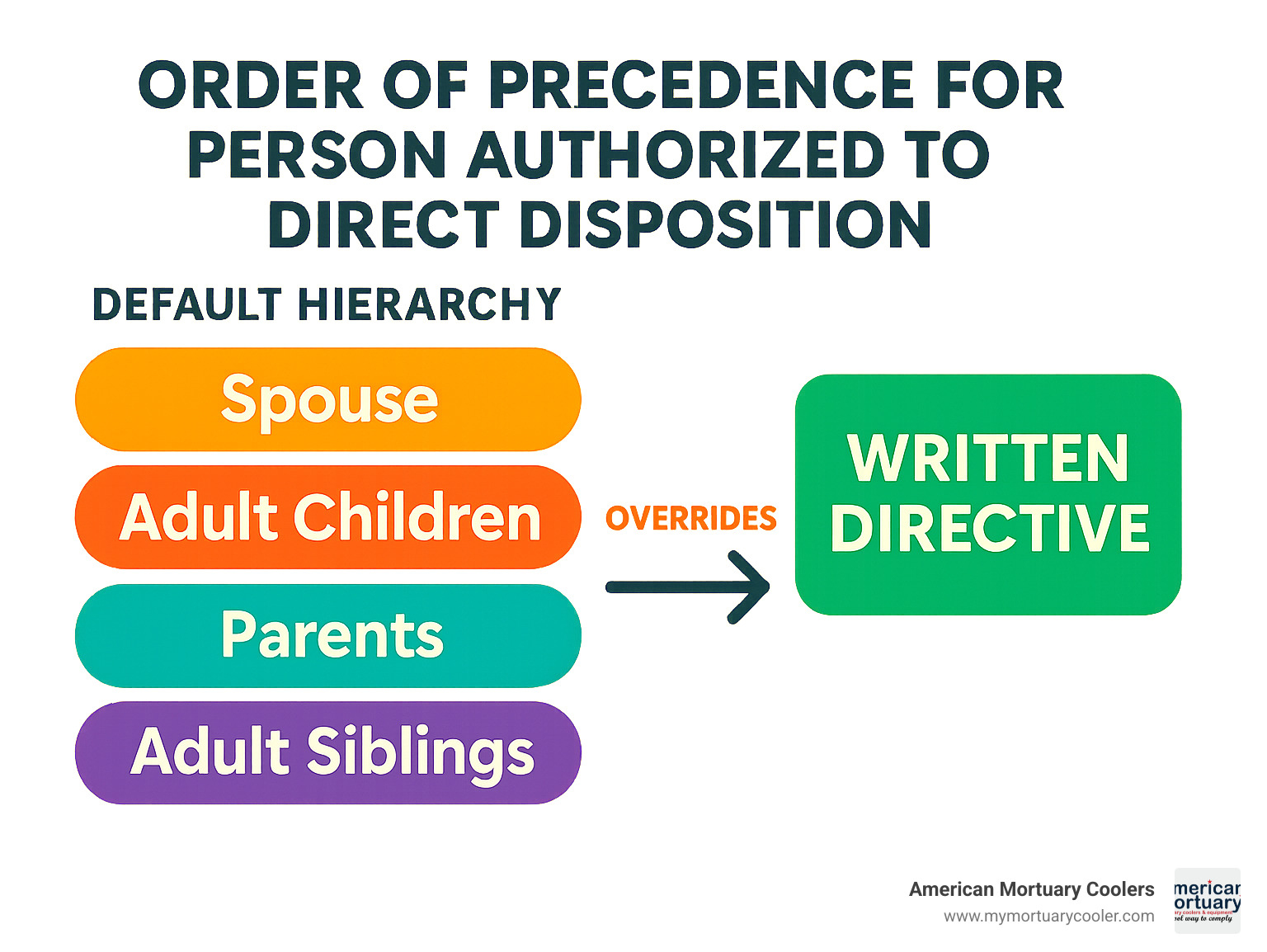Who Has Legal Authority Over Your Remains?
A Person Authorized to Direct Disposition (PADD) is the individual legally authorized to make decisions about what happens to someone's body after death. This includes funeral arrangements, burial or cremation choices, and other final disposition decisions.
Quick Answer: Person Authorized to Direct Disposition
| Question | Answer |
|---|---|
| Who is a PADD? | The person legally authorized to make decisions about the disposition of remains after death |
| How is a PADD determined? | 1) Through written designation (DD Form 93 for military, notarized document for civilians) 2) By default order of precedence if no designation exists |
| Default order (if not designated) | Usually: 1) Spouse, 2) Adult children, 3) Parents, 4) Adult siblings, 5) Next of kin |
| Military vs. civilian | Military members designate PADD on DD Form 93; civilians use state-specific forms or notarized documents |
| Can it be changed? | Yes, by completing a new designation form that revokes previous appointments |
Understanding who has the legal right to direct disposition is crucial for both advance planning and during the immediate aftermath of a death. Without clear designation, families can face delays and disputes during an already difficult time.

Relevant articles related to person authorized to direct disposition:
Understanding the Person Authorized to Direct Disposition (PADD)
When someone passes away, who decides what happens to their body? This question has real, immediate consequences for families and funeral providers. The person authorized to direct disposition (PADD) is the individual who legally holds this important responsibility.
For military members, this designation happens officially on DD Form 93, also known as the Record of Emergency Data. This form allows service members to name exactly who they trust with these sensitive decisions should the unthinkable happen during their service.
For civilians, naming a PADD works differently. You can designate someone through a written instrument—typically a will, advance directive, or a specific form designed for this purpose in your state.
If someone hasn't named anyone, all 50 states and DC have established a clear pecking order that typically follows this pattern: surviving spouse first, then adult children, parents, adult siblings, and continuing outward through the family tree.
Why the term "person authorized to direct disposition" matters
This somewhat formal term carries real weight in the funeral industry. When a person authorized to direct disposition steps forward, they don't just have an opinion—they have legal standing to make binding decisions about cremation, burial, and funeral arrangements.
For funeral homes and crematoriums, this clarity isn't just helpful—it's essential. These businesses must have proper authorization before they can proceed with services.
At American Mortuary Coolers, we've supported funeral homes through challenging situations. Our cooling systems often provide the necessary time for legal questions about disposition authority to be properly resolved.
Primary keyword in military regulations
In military contexts, the person authorized to direct disposition is governed by specific regulations. Department of Defense Instruction 1300.18 establishes clear procedures for determining who has authority over a service member's remains.
The military takes this designation seriously, requiring service members to update their DD Form 93 regularly. These regular reviews ensure that current wishes are accurately recorded and respected.
One important distinction: the PADD designation on a military DD Form 93 overrides the default family hierarchy. This means service members can designate someone other than their spouse or next of kin if they choose. This flexibility isn't always available in civilian contexts, where some states restrict the ability to designate someone outside the family tree.
How to Designate or Change Your PADD in Advance

Planning ahead for your final arrangements is one of the most caring things you can do for your loved ones. A crucial part of this process is naming your person authorized to direct disposition – the individual who'll make decisions about your remains when you're gone.
The way you designate your PADD depends on whether you're serving in the military or are a civilian. Each path has its own forms and requirements, but both achieve the same important goal: ensuring your wishes are honored.
For those in military service, the process centers around the DD Form 93. Military members should review this form yearly or after major life changes like marriage, divorce, or having children.
Civilians have several options that vary by state. You might complete a state-specific disposition form, include instructions in your will, add post-death directions to your healthcare power of attorney, or create a separate notarized statement naming your agent. Most states require written documentation with either notarization or two adult witnesses.
Completing DD Form 93 correctly
Military members need to pay special attention to the DD Form 93. This isn't just another form in your file – it's the legal document that determines who makes decisions about your remains.
Contrary to what some believe, married service members don't have to name their spouse as their person authorized to direct disposition. While many do choose their spouse, others prefer to designate a parent, sibling, or another trusted person.
The military now maintains this form electronically through personnel systems. Make it a habit to review your DD Form 93 annually and after significant life events.
Civilian options for naming a PADD
For those not in the military, all 50 states now provide ways to designate a person authorized to direct disposition, though the specific process varies by location.
Many states offer dedicated forms for this purpose. New York provides the "Appointment of Agent to Control Disposition of Remains" (Form DOH-5211), while Texas outlines their process in Section 711.002 of the Health and Safety Code.
Perhaps the most effective approach is creating a short, focused document that specifically addresses disposition instructions. This document should clearly identify you and your chosen agent, explicitly state that you're appointing this person to control your remains, include any specific wishes, name backup agents, and be properly signed and witnessed.
For more guidance on this important decision, you might find helpful information about choosing a funeral home that aligns with your values and preferences.
How to change a previously named person authorized to direct disposition
Life changes, and your choice of who should handle your final arrangements might need to change too. Updating your person authorized to direct disposition follows a similar process to your initial designation.
For military personnel, simply update your DD Form 93 with your new selection. The most recent form automatically overrides any previous designations.
For civilians, create a new designation document that includes clear language revoking all prior appointments. Most state forms include a statement like: "I hereby revoke any prior appointment of any person to control the disposition of my remains."
You may also want to review the Appointment Of Agent To Control Disposition Of Remains for additional guidance on this process.
Rights, Responsibilities & Options for the Person Authorized to Direct Disposition

When someone names you as their person authorized to direct disposition, they're entrusting you with incredibly meaningful responsibilities. It's not just paperwork—it's the final acts of care you'll provide on their behalf.
If you find yourself in this role, you have the legal authority to make all the arrangements after a death occurs. You'll decide whether your loved one is buried or cremated, which funeral home will care for them, and whether they'll have a viewing. You'll choose their final resting place and select the casket or urn. For veterans, you'll coordinate military honors, and in some cases, you might need to authorize organ donation if it wasn't arranged beforehand.
These rights come paired with real responsibilities. You'll need to honor any wishes the person expressed while living, make decisions promptly, and steer the financial aspects of funeral planning.
PADD financial considerations and military reimbursements
Money matters can feel uncomfortable to discuss during bereavement, but they're an unavoidable part of the person authorized to direct disposition's role.
For military families, there's significant financial support available. When an active-duty service member dies, the Department of Defense covers authorized funeral and burial expenses completely. This includes preparing the body, purchasing a casket or urn, transportation to the cemetery or crematory, burial costs, and travel expenses for family attending the funeral.
Military PADDs have several disposition options, each with specific funding allowances. Many choose "Option 5," which lets them work with a civilian funeral home while still accessing military benefits.
For civilian deaths, financial responsibility typically falls to either the deceased's estate or sometimes to the PADD personally. Look for relief through pre-paid funeral plans, life insurance policies with funeral assignments, veterans benefits for those who served, or the modest Social Security death benefit of $255 for qualified recipients.
Can the person authorized to direct disposition decline or transfer authority?
Yes, if you've been named as someone's person authorized to direct disposition but feel unable to fulfill this role, you can step aside. Life circumstances might make this necessary—perhaps you live across the country, or the emotional weight feels too heavy to bear.
If you decline to serve, the authority typically transfers to any successor agents named in the original document. If none exist, it passes to the next person in your state's statutory hierarchy, or occasionally to a court-appointed representative.
The process for stepping aside varies by state but generally requires a written statement. Some states have specific legal procedures—Louisiana, for instance, might require a district court judgment before allowing someone else to make disposition decisions.
Popular disposition choices the PADD may select
As the person authorized to direct disposition, you'll face several meaningful choices about how to honor your loved one's remains.
Traditional burial remains common, typically involving embalming, a casket, and burial in a cemetery plot. For those with environmental concerns, green or natural burial offers a more eco-friendly approach. Some families prefer above-ground entombment in a mausoleum or lawn crypt.
Cremation has grown increasingly popular, offering flexibility in keeping, burying, or scattering the ashes in meaningful locations. Some choose anatomical donation, giving the body to medical research or education.
Military families might consider burial at sea, a dignified option the Navy and Coast Guard offer at no charge, complete with military ceremony.
For those interested in learning more about organ donation options, the national organ donor registry provides comprehensive information. Military families considering burial at sea can find detailed guidance through the Navy's Burial at Sea program.
State vs. Military Rules & Conflict Resolution
When it comes to who gets to make decisions about a loved one's remains, the rules can feel like a maze. Military regulations and state laws don't always align, creating challenges for families during an already difficult time.
For active-duty service members who pass away, the person authorized to direct disposition named on their DD Form 93 takes priority—period. This military designation trumps state laws and gives funeral homes clear direction.
For civilians, each state has created its own set of rules about who can make these decisions, with significant differences:
Some states like New York specifically include domestic partners in their priority lists, while others don't acknowledge these relationships. The military specifically excludes step-parents and step-siblings unless they've legally adopted the deceased, but states vary widely on this point. In some states, when multiple children have equal rights, they must reach a majority agreement, while other states have special procedures for breaking ties.

Resolving disputes when multiple parties claim authority
Family disagreements about who should make final arrangements can quickly become heartbreaking. When multiple people believe they're the rightful person authorized to direct disposition, there are several paths forward.
Many funeral homes offer mediation services to help families find common ground. When mediation doesn't work, funeral homes typically pause the process until the dispute is resolved. This is why at American Mortuary Coolers, we design our cooling units to maintain dignity and preservation during these unfortunate delays.
In the most difficult cases, families may need to seek emergency court orders to determine who has the legal right to proceed. The simplest resolution comes when someone can present a properly executed written designation that clearly names them as the agent.
What happens if no PADD or next of kin is available?
Sometimes, there simply isn't anyone available or willing to make these decisions. When no person authorized to direct disposition steps forward, responsibility typically falls to local government officials.
The county's Public Administrator may take charge—these officials handle estates of people who die without known heirs. In some cases, the county Coroner or Medical Examiner will make disposition decisions. Many counties have specific programs for indigent burials when no one claims the remains.
This is why designating someone you trust as your person authorized to direct disposition is so important. Without clear instructions, your final arrangements may not reflect your wishes or values at all.
Special family situations and the person authorized to direct disposition
Today's families often have beautiful complexity—blended families, multiple marriages, adoptions, and close non-biological relationships. This richness can create challenges when determining who should make final arrangements.
When someone has been married multiple times, tensions often arise between the current spouse and children from previous marriages. While legally adopted children have the same rights as biological children, informal "like family" relationships generally aren't recognized in these situations.
Military regulations have special provisions for people who stood in loco parentis (in place of parents) for at least one year, but only under specific conditions. And while blended families are increasingly common, step-parents and step-siblings are specifically excluded from person authorized to direct disposition authority under military regulations unless they've legally adopted the deceased.
Frequently Asked Questions about the Person Authorized to Direct Disposition
Who ranks first if no written PADD exists?
When someone hasn't designated a person authorized to direct disposition in writing, the law doesn't leave things to chance. There's a clear pecking order that kicks in automatically.
For most civilians, state laws follow a predictable pattern. Your spouse usually gets first priority on making these important decisions. If you're not married or your spouse has passed away, the responsibility typically falls to your adult children. Parents come next in line, followed by your adult siblings. If none of these folks are available, more distant relatives might be called upon, and in truly unfortunate cases where no family can be located, a public official steps in.
Military personnel have their own slightly more detailed hierarchy spelled out in Department of Defense Instruction 1300.18. It starts with the unremarried surviving spouse and works its way down through children, parents (but not step-parents unless they legally adopted you), siblings, grandparents, and so on.
Can I name a friend instead of family as my PADD?
Absolutely! Your best friend from college, your neighbor of 20 years, or even your longtime barber can be your person authorized to direct disposition if that's what you want.
For service members, it's straightforward—DD Form 93 lets you name anyone you choose. That designation trumps the default hierarchy and carries legal weight that funeral homes must respect.
On the civilian side, all 50 states plus DC now allow you to name a non-family agent to handle your remains. The key is following your state's rules for making it official—usually involving the right form, proper witnesses or notarization, and your agent's signature accepting this responsibility.
Does a PADD have to pay funeral costs out-of-pocket?
The financial side of being named person authorized to direct disposition often causes anxiety, but the situation isn't as scary as many fear.
For active-duty military deaths, the Department of Defense covers 100% of authorized funeral and burial expenses. The PADD makes the decisions but doesn't have to worry about the bill.
For civilians, funeral expenses are considered a debt of the deceased's estate—meaning they should be paid from whatever assets the person left behind before most other debts get settled. The PADD isn't automatically on the hook financially just because they're making the arrangements.
That said, whoever signs the funeral contract (often the PADD) may become personally responsible if the estate can't cover the costs. This is why it's important to consider the financial picture before making arrangements.
Smart PADDs investigate all potential benefits that might help cover costs—veterans' benefits, Social Security's modest $255 death benefit for qualified recipients, life insurance payouts, pre-paid funeral plans, and even employer death benefits or workers' compensation for work-related deaths.
Conclusion
Planning for what happens after we're gone isn't easy, but it's one of the most thoughtful gifts we can leave our loved ones. Throughout this guide, we've explored how the person authorized to direct disposition serves as the legal decision-maker for your final arrangements – the individual who will ensure your wishes are honored when you can no longer speak for yourself.
Whether you're active military completing your DD Form 93 or a civilian creating state-specific documents, taking the time to officially name your PADD now can prevent heartache and confusion later. I've seen families spend precious grieving time locked in disagreements that could have been avoided with a simple designation form.
Think of PADD designation as the final act of love for your family – clear instructions that guide them through difficult decisions when emotions are running high. When you name someone you trust, discuss your wishes openly with them, and document everything properly, you're removing an enormous burden from your loved ones' shoulders.
Remember to revisit your designation after major life changes. The person you trusted at 25 might not be the same person you'd choose at 45. Marriage, divorce, relocation – all these milestones are natural times to reconsider who should have this important responsibility.
Here at American Mortuary Coolers, we work with funeral homes across the country, from small family operations in rural communities to large urban facilities. Our custom cooling solutions support these professionals as they care for loved ones during the time between death and final disposition.
By taking action now to formally designate your person authorized to direct disposition, you're doing more than just completing paperwork – you're creating peace of mind. You're ensuring your wishes will be respected, preventing potential family conflicts, and providing clear authority to someone you trust during a difficult time.
For funeral professionals seeking reliable equipment that supports their important work with families and PADDs, we invite you to explore our custom mortuary cooling solutions. We deliver directly to funeral homes across the contiguous 48 states, providing the durable, custom equipment that helps you serve families with dignity during their most difficult moments.


















